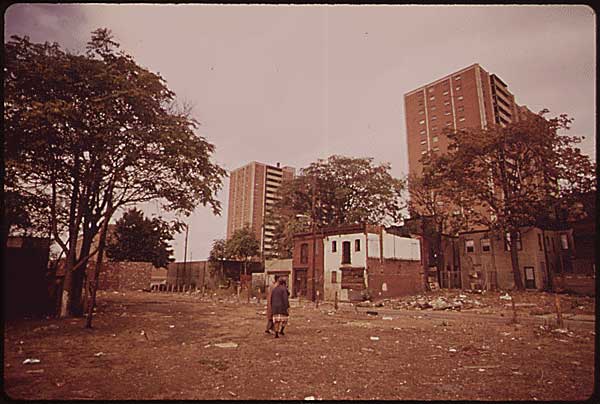Public Housing
Nationwide, the first public housing projects were made possible by the New Deal’s Public Works Administration (PWA) program and later by the U.S. Housing Act of 1937. The Act of 1937 (also known as the Wagner-Steagall Act), provided subsidies to construct, own and manage public housing to local public housing agencies for “families whose incomes are so low that they cannot afford adequate housing provided by private enterprise” (Federal Works Agency, "Public Housing: The Work of the Federal Public Housing Authority"). The United States Housing Authority (USHA) was created and empowered by Congress to “provide loans (up to 90% of development costs at 3% interest) to local government bodies or authorities to construct low-rent housing projects. The Act included a ‘statutory cost limit per unit exclusive of land costs’” (D. Bradford Hunt, "What Went Wrong with Public Housing in Chicago? A History of the Robert Taylor Homes"). Pennsylvania Legislature approved the Housing Authorities Law of Pennsylvania in an Act of Assembly on 28 May 1937. This law established public agencies known as local housing authorities, and “required a local legislative body to declare a need for a local housing authority in order for one to be created.”
By the end of World War II, cities in Pennsylvania and nationwide were facing housing shortages, loss of industrial and manufacturing economic bases, blight, and so on. In an effort to combat the decline of cities, in 1945, the Pennsylvania State Legislature enacted the Urban Redevelopment Act which “promoted elimination of blighted areas and supply sanitary housing in areas throughout the Commonwealth; declaring acquisition, sound replanning and redevelopment of such areas to be for the promotion of health, safety, convenience and welfare; creating public bodies corporate and politic to be known as Redevelopment Authorities; authorizing them to engage in the elimination of blighted areas and to plan and contract with private, corporate or governmental redevelopers for their redevelopment…” (Urban Redevelopment Law, Act of May 24, 1945 Public Law 991).
Housing authorities generally followed Harold Ickes’ PWA formula that “the racial composition of a project should conform to the prevailing racial composition of the surrounding area,” and nationwide, cities had black and white dual housing markets (intentional or non-intentional racial segregation) (John F. Bauman, Public Housing, Race and Renewal: Urban Planning in Philadelphia, 1920-1974). Nearly every city in the United States saw an acute rise in African American population between 1940 and 1960, just in the northeast and Midwestern cities saw New York City’s African American population rising by 137%, Philadelphia by 111%, Cleveland by 197%, Detroit by 223%, Chicago by 193%, Newark by 200%, Buffalo by 301%, and Milwaukee by 607% (Raymond Mohl, "Race and Housing in the Postwar City: An Explosive History").
“Public housing policies played an especially important role in shaping the racial dynamics of the postwar city….public housing projects absorbed low-income black families whose housing had been demolished through urban renewal, highway construction, and code enforcement. Essentially, these housing projects solidified black ghettoization in the postwar era. Designed to prevent racial transitions and to maintain a rigid color line in urban housing, the massive housing projects also impelled working-class and middle-class blacks to newer second ghetto neighborhoods.”[8] To find out about public housing in Philadelphia, read BHP's overview of Philadelphia's postwar public housing projects and the Philadelphia Housing Authority (PDF). Also see John F. Bauman's "Expressways, Public Housing and Renewal: A Blueprint for Postwar Philadelphia, 1945-1960."
Temple University's Urban Archives which was established in 1967 to document the social, economic, and physical development of the Philadelphia area from the mid-19th century to the present, functions as a repository for organizational records and related materials, and as a research facility for those interested in urban studies. Their Pamphlet Collections (which includes the Annual Reports Collection) is an excellent resource.
Public Housing Records at Pennsylvania State Archives
RG-79 Records of the Pennsylvania Housing and Finance Agency. The Pennsylvania Housing and Finance Agency (PHFA) is a public corporation and governmental office created in 1972 by the General Assembly to finance the development of multi-family rental housing for elderly citizens, families of low and moderate income, and people with special needs.
RG-34 Department of Community Affairs; Bureau of Community Development; Community Plans and Studies. Included in these records are comprehensive plans for various improvement projects for communities, cities, boroughs, and counties throughout the state. These plans were financed by various agencies under the provisions of Section 701 of the Housing Act of 1954, as amended and administered by the Bureau of Community Development, Pennsylvania Department of Community Affairs. Many of the plans address population analysis, economic structures, existing land use, highway systems, and community facilities. Topics of plans and proposals include general development, proposed zoning ordinances, comprehensive studies, capital improvements, and regional evaluations.
MG-207 George M. Leader Papers; topics include Housing reports, Citizens' Committee, Housing Authorities, Housing Study Commission on Discrimination, see also "Guide to African American Resources at the Pennsylvania State Archives" for the George M. Leader papers.
MG-209 Governor Raymond P. Shafer Papers; Boards and Commissions Files; Pennsylvania Housing Agency, 1968-1970; Housing, Governor's Seminar on Public Housing; Task Force on Housing; Housing and Urban Development. See also "Guide to African American Resources at the Pennsylvania State Archives" for the Raymond P. Shafer Papers
|
Thousands of people who were formerly the victims of scurrilous, profit-greedy landlords, that provided dwellings of the most dilapidated sub-standard grade, many being potential fire traps and breeding places for diseases, now live, laugh and are happier with a new lease on life in the clean, modern, and healthful surroundings of the Raymond Rosen Projects. Lloyd King |
 |